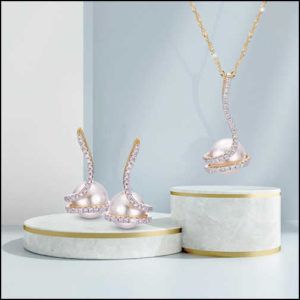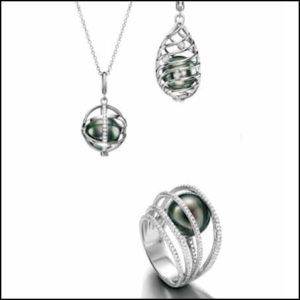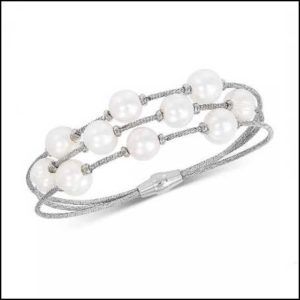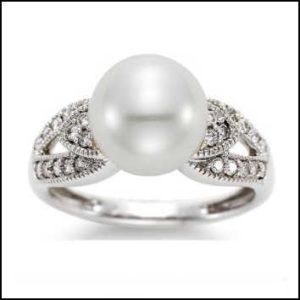Pearls’ Sustainable Message
Pearls are the only renewable gemstone on the planet.
Unlike any other gem, pearls are organic, created inside a living mollusk. Regardless of whether it forms naturally or is cultured by man with care, pearls develop in the water amidst plants, animals, and often fragile ecosystems.
In many respects, pearls are uniquely qualified to capture Millennial and Gen Z jewelry consumers. With climate change and global warming raising the issue of environmental sustainability to the top of their agenda, the ability of responsibly cultured pearls to be a renewable resource and at the same time contribute to the health of the ocean biosphere provides them with unique appeal. Moreover, pearl farming sustains families, offering economic development opportunities to remote communities.
“Because pearls and their oysters should be cultivated in pristine marine environments, pearl producers have an inherent need for marine conservation,” explains Dr. Laurent Cartier, a pearl and gemstone specialist at the Swiss Gemological Institute in Basel, Switzerland, and one of the world’s preeminent experts in sustainability in the cultured pearl sector.
Unlike a mine that has a finite life span, a pearl farm can continue producing indefinitely on condition that it is responsibly operated. Such responsible practices, Cartier explains, are more likely to be applied in places where sustainable social and economic opportunities are also present. It has the potential to be a sustainable luxury product and a great medium to engage with and educate consumers.
Pearls’ Goodness
“Pearls have a wonderful story of goodness — a story of passion, love, sustainability, economic opportunity — pearls have it all,” shares Kathy Grenier, vice president of business development for Imperial in Providence, Rhode Island.
Grenier underscores that we exist in a world where people want meaningful jewelry that withstands time. “The people behind the jewels matter, too,” she says. “Who are they, and what do they stand for? What are the gems and metals used, and where are they sourced? These questions are more important than ever. Equally important are the benefits to people, the economy, and the environment from the creation of pearl jewelry. Luckily, pearls are best positioned to shine in this conversation.”
In awe of pearls, Grenier sees a common denominator in the life span of pearls and people who converge in a struggle to overcome adversity. “Perhaps this is why I’m drawn to this gem like no other,” she shares. “People have no shortage of hardships in life, and so does the pearl, including fighting off hungry predators and intruders that may cause the growing pearl to shift. But even when obstacles interfere, and the resulting pearl isn’t ‘perfect,’ it will still have a beauty worth appreciating. The stewards of both people and pearls must protect the health and safety of their wards — just as with families, care, patience, and respect drive the future and the next generation of pearls. No two pearls or people are alike, but both come in many shapes, sizes, and varieties ready for appreciation.”
Pearls have a compelling story to tell, concurs Sarah Cuidon, marketing and communications for the New York pearl house Mastoloni, who is equally attracted to this gem. “It’s so different than any other gemstone. Organic and natural, the pearl is connected to life, symbolic of rebirth and renewal. There is something so special about the way it shines, a gem that glows from within.”
Engaging Pearl Talk
Regarding marketing pearls, leading pearl houses like Imperial, Mastoloni, and Honora have all the bells and whistles that retail jewelers need, from branded displays and packaging to a library of high-resolution images and custom advertising material for print and online campaigns.
“We don’t sell directly to consumers, but we empower our retailers with all the resources they need to market pearls,” says Cuidon. “We reach out to them monthly with new images, recommended hashtags, and information regarding what’s in a style they can use in their social media and marketing.”
Cuidon notes that Mastoloni is making those resources more accessible for its clients through The Plumb Club’s virtual B2B TPC365 sales meeting platform on the group’s website. “We’re focused on giving as much information to our retailers as possible to sell pearls successfully.”
Grenier, who also serves as marketing director for the Cultured Pearl Association, hails CPAA as a beautiful resource for knowledge and marketing materials that jewelers should tap into as well, including educational flash cards, videos of pearling regions, and a pearl specialist certification course known as Pearls As One.
Honora, a Richline brand based in New York, advocates that pearls and romance are much easier to talk about than diamonds. It’s all in the luster. Honora promotes “Genuine Pearls for Real People,” sharing stories on social media with hashtags like #FindYourLuster, #PearlsthatGoWith, and #PearlsAreForEveryone.
Social media is a critical communication tool in today’s fluid shopping environment, as consumers look to these platforms for inspiration, advice, and ideas, with Instagram and Pinterest viral for pearl jewelry.
Grenier underscores how important it is to provide content with the intended end user in mind, which is something brands like Imperial work hard to provide retailers to help them quickly communicate the right messages.
Raymond Mastoloni Jr. applauds his retail customers for engaging their client base during these COVID times by amplifying their social media efforts, email campaigns, and good old-fashioned clientele-ing through virtual meetings, events, and other customer services. These efforts, he says, have resulted in closer relationships with customers.















